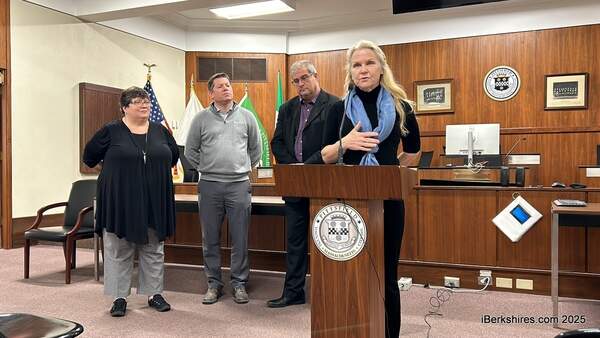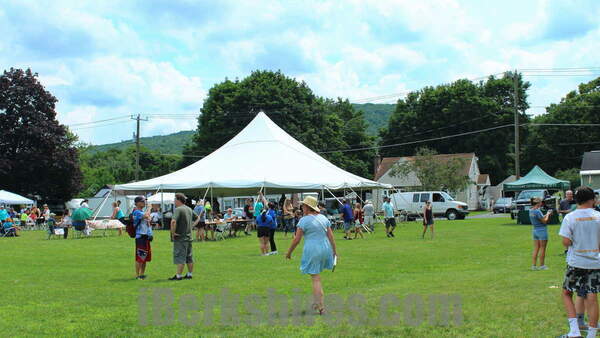
These Mysterious Hills: Pontoosuc's Lost Lovers Legend is Classic Local Lore
 Pontoosuc Lake or shall we refer to it as Shoonkeek-Moonkeek? |
Pontoosuck, as it was then simply known, a "field for winter deer," and the lake to its north served as a good home for these brothers for many years. One bore a son, who he called Shoon-keek, and one a daughter, Moon-keek.
"These two grew up together, racing the trails of the virgin forests, swimming in the clear waters of the lake, or skimming its surface in birch-bark canoes," wrote local historian Haydn Mason, in the 1948 anthology Berkshires: The Purple Hills.
As they grew older, however, the beauty of the young maiden drew braves from surrounding areas. Suitors jealous of the inseparability of the Moon-keek and her brother complained, maligning the two to their fathers.
Their fathers forbid them, as cousins, to settle together, and went to lengths to keep the two apart. But Moon-keek and Shoon-keek found many opportunities to evade watchful eyes in the ranging forests all around their lakeside settlement.
It was on one such stealthy tryst that they decided that their happiness demanded a more permanent solution, and they determined to run away, find another tribe and settle down together.
Their planning, however, was observed in secret by one of the maiden's jealous suitors, a brave named Nockawondo. On the night they set for their escape, Nockawondo (Obiway, in some versions) followed as they prepared to meet out on the lake's tiny island.
Moon-keek reached the island first, and could hear the paddling of Shoon-keek's canoe on the water in the deathly still of the night... but they were not alone. Consumed with hatred, Nockawondo let an arrow fly across the dark lake. Shoon-keek was struck, and fell from his canoe with a splash.
Moon-keek leapt back into her canoe. "Shoon-keek! Shoon-keek! she cried, paddling furiously. When she found the place where he had gone under, she dived in after, her empty canoe drifting on alongside his.
She never resurfaced.
In somber remembrance, their people named the lake for the lost youngsters, the lovers who would not be parted.
There is some evidence that the lake was indeed referred to as Moonkeek-Shoonkeek by the Mahican natives first encountered by settlers. A reference to Pontoosuc Lake in an 1862 item in the Berkshire County Eagle suggests the native moniker was a traditional one that hearkened back a considerable span of time by that time.
The legend was widely established by the mid to late 19th century, and treated as quite traditional by 1878, in Godfrey Greylock's Taghconic: Romance and Beauty of the Hills, a pen name chronicle by the preeminent Pittsfield historian Joseph E.A. Smith, and referenced again in the 1885 History of Berkshire County.
From there it made its way into many of the popular local folk histories, from Katherine Abbot's Old Paths and Legends of the New England Border to Willard Douglas Coxey's Ghosts of Old Berkshire to Grace Greylock Niles' The Hoosac Valley: Its Legends and Its History.
It was Niles' 1907 tome that reminded me again of the broader context, in quoting William Cullen Bryant's 1815 poem "Monument Mountain." Like poor Moon-keek, the unnamed heroine of Bryant's telling is ultimately doomed by a romance deemed incestuous by her people, and ends her life, in that case in a dive from the place called Devil's Pulpit on the Mountain of the Monument.
The Pontoosuc maiden is connected to a whole body of era lore, of "lovers leaps," seen at Monument, and at Bash-Bish Falls and even even one obscure version of east county legend in which the fair Wahconah meets her death leaping over the falls instead of living happily ever after with her Wampanoag refugee paramour.
It is part of a chain of such legends to be found across the Northeast, tales which modern scholars tend to see as more indicative of the ideas of the conquering culture than that of the conquered culture depicted. It was, perhaps, a less guilt-inducing way of conceptualizing their observations of the very real rates of suicide that do tend to occur in a culture under the pressures of assimilation and decimation.
The name and lore of the lost lovers has been preserved in a variety of ways over since, from a local branch of the Improved Order of Red Men, the country's oldest fraternal society, which flourished here under the name of the Shoonkeek Council of Pittsfield beginning in 1914, to its more recent inspiration of a popular float in the 2010 Fourth of July parade.
And, some still say, on a still night on the shores of old Pontoosuc, you may yet hear the light splashing sounds of two canoes floating gently across the lake, and the mournful whispers of the tragic young lovers... "Shoon-keek.... Moon-keek..."
These Mysterious Hills is a production of writer Joe Durwin and more mysterious goings on can be found here.















